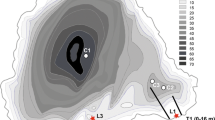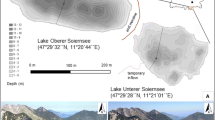Abstract
We measured variability in the composition of diatom and chrysophyte assemblages, and the pH inferred from these assemblages, in sediment samples from Big Moose Lake, in the Adirondack Mountains of New York. Replicate samples were analyzed from (1) a single sediment core interval, (2) 12 different intervals from each of 3 separate cores, and (3) 10 widely spaced surface sediment samples (0–1 cm). The variability associated with sample preparation (subsampling, processing, and counting) was relatively small compared to between-core and within-lake variability. The relative abundances of the dominant diatom taxa varied to a greater extent than those of the chrysophyte scale assemblages. Standard deviations of pH inferences for multiple counts from the same sediment interval from diatom, chrysophyte, and diatom plus chrysophyte inference equations were 0.04 (n=8), 0.06 (n=32), and 0.06 (n=8) of a pH unit, respectively. Stratigraphic analysis of diatoms and chrysophytes from three widely spaced pelagic sediment cores provided a similar record of lake acidification trends, although with slight differences in temporal rates of change. Average standard deviations of pH inferences from diatom, chrysophyte and diatom plus chrysophyte inference equations for eight sediment intervals representing similar time periods but in different cores were 0.10, 0.20, and 0.09 pH unit, respectively. Our data support the assumption that a single sediment core can provide an accurate representation of historical change in a lake. The major sources of diatom variability in the surface sediments (i.e., top 1.0 cm) were (1) differences in diatom assemblage contributions from benthic and littoral sources, and (2) the rapid change in assemblage composition with sediment depth, which is characteristic of recently acidified lakes. Because scaled chrysophytes are exclusively planktonic, their spatial distribution in lake sediments is less variable than the diatom assemblages. Standard deviations of pH inferences for 10 widely spaced surface sediment samples from diatom, chrysophyte and diatom plus chrysophyte inference equations were 0.21, 0.09, and 0.16 of a pH unit, respectively.
Similar content being viewed by others
References
Anderson, N. J., 1989. A whole-basin diatom accumulation rate for a small eutrophic lake in Northern Ireland and paleoecological implications. J. Ecol. 77: 926–946.
Binford, M., 1990. Calculation and uncertainty analysis of 210Pb dates for PIRLA project lake sediment cores. J. Paleolim. 3: 253–267.
Birks, H. J. B., 1985. Recent and future mathematical developments in quantitative palaeocology. Palaeogeogr., Palaeoclimatol., Palaeocol. 50: 107–147.
Birks, H. J. B., J. M. Linee, S. Juggins, A. C. Stevenson & C. J. F.ter Braak, 1990. Diatoms and pH reconstruction. Phil. Trans. r. Soc., Lond. B 327: 263–278.
Blake, G. & S. A. Norton, 1986. Lead-210 dating. In D. F. Charles and D. R. Whitehead (eds.). Paleoecological Investigation of Recent Lake Acidification (PIRLA): Methods and project description. EPRI EA-4906. Electric Power Research Institute, Palo Alto, CA: 9–1 to 9–4.
Brakke, D. F., D. H. Landers & J. M. Eilers, 1988. Chemical and physical characteristics of lakes in the Northeastern United States. Envir. Sci. Technol. 22: 155–163.
Charles, D. F., 1984. Recent pH history of Big Moose Lake (Adirondack Mountains, New York, U.S.A.) inferred from sediment diatom assemblages. Verh. int. Ver. Limnol. 22: 559–566.
Charles, D. F., 1985. Relationships between surface sediment diatom assemblages and lakewater characteristics in Adirondack lakes. Ecology 66: 994–1011.
Charles, D. F. & J. P. Smol, 1988. New methods for using diatoms and chrysophytes to infer past pH of low-alkalinity lakes. Limnol. Oceanogr. 33: 1451–1462.
Charles, D. F., 1986. A new diatom species, Fragilaria acidobiontica, from acidic lakes in northeastern North America. In J. P. Smol, R. W. Battarbee, R. B. Davis & J. Meriläinen (eds). Diatoms and lake acidity. Dr W. Junk, Dordrecht, The Netherlands: 35–44.
Charles, D. F., 1987a. Diatom counts of Adirondack lake surface sediment samples. PIRLA Unpublished Report Series, Report Number 11, Indiana University, Bloomington, IN.
Charles, D. F., 1987b. Diatom counts of Adirondack lake surface sediment samples. PIRLA Unpublished Report Series, Report number 12, Department of Biology, Indiana University, Bloomington, IN. 393 pp.
Charles, D. F. & J. P. Smol, 1988. New methods for using diatoms and chrysophytes to infer past pH of low-alkalinity lakes. Limnol. Oceanogr. 33: 1451–1462.
Charles, D. F. & D. R. Whitehead, (eds) 1986. Paleoecological Investigation of Recent Lake Acidification (PIRLA): Methods and Project Description. EPRI EA-4906 Electric Power Research Institute, Palo Alto, CA. 228 pp.
Charles, D. F., J. P. Smol, A. J. Uutala, P. R. Sweets & D. R. Whitehead, 1989. The PIRLA DataBase Management System. INQUA — Commission for the Study of the Holocene. Newsletter of the Working Group on Data Handling Methods. 2: 3–6.
Charles, D. F., D. R. Whitehead, D. R. Engstrom, B. D. Fry, R. A. Hites, S. A. Norton, J. S. Owen, L. A. Roll, S. C. Schindler, J. P. Smol, A. J. Uutala, J. R. White & R. J. Wise, 1987. Paleolimnological evidence for recent acidification of Big Moose Lake, Adirondack Mountains, N.Y. (USA). Biogeochemistry 3: 267–296.
Cumming, B. F., J. P. Smol & H. J. B. Birks, 1991. The relationship between sedimentary chrysophyte scales (Chrysophyceae and Synurophyceae) and limnological characteristics in 25 Norwegian lakes. Nord. J. Bot. (in press).
Cushing, E. J. & H. E. Wright Jr., 1965. Hand operated piston corers for lake sediments. Ecology 46: 380–384.
Davis, M. B. & M. S. Ford, 1982. Sediment focusing in Mirror Lake, New Hampshire. Limnol. Oceanogr. 27: 137–150.
DeNicola, D. M., 1986. The representation of living diatom communities in deep-water sedimentary diatom assemblages in two Maine (USA) lakes. In J. P. Smol, R. W. Battarbee, R. B. Davis & J. Meriläinen (eds). Diatoms and Lake Acidity. Dr W. Junk Publishers, Dordrecht, The Netherlands: 73–85.
Dixit, S. S. & Evans, 1986. Spatial variability in sedimentary algal microfossils and its bearing on diatom-inferred pH reconstructions. Can. J. Fish. aquat. Sci. 43: 1836–1845.
Dixit, S. S., A. S. Dixit & J. P. Smol, 1989. Relationship between chrysophyte assemblages and environmental variables in seventy-two Sudbury lakes as examined by canonical correspondence analysis (CCA). Can. J. Fish. aquat. Sci. 46: 1667–1676.
Dixit, S. S., J. P. Smol, D. S. Anderson & R. B. Davis, 1990. Utility of scaled chrysophytes for inferring lakewater pH in northern New England. J. Paleolim. 3: 269–286.
Driscoll, C. T., 1980. Chemical characterization of some dilute acidified lakes and streams in the Adirondack region of New York State. Ph.D. dissertation, Cornell University, Ithaca.
Driscoll, C. T. & R. M. Newton, 1985. Chemical characteristics of Adirondack lakes. Envir. Sci. Technol. 19: 1018–1024.
Earle, J. C., H. C. Duthie, W. A. Glooschenko & P. B. Hamiliton, 1988. Factors affecting the spatial distribution of diatoms on the surface sediments of three Precambrian shield lakes. Can. J. Fish. aquat. Sci. 45: 469–478.
Esterby, S. R. & A. H. El-Shaarawi, 1981a. Likelihood inference about the point of change in a regression regime. J. Hydrobiol. 53: 17–30.
Esterby, S. R. & A. H. El-Shaarawi, 1981b. Inference about the point of change in a regression model. J. App. Stat. 30: 277–285.
Gordon, A. D., 1973. A sequence comparison statistic and algorithm. Biometrika 60: 197–200.
Hongve, D., 1972. En bunnhenter som er lett a lage. Fauna 25: 281–283.
Jones, V. J. & R. J. Flower, 1986. Spatial and temporal variability in periphytic diatom communities: paleoecological significance in an acidified lake. In: J. P. Smol, R. W. Battarbee, R. B. Davis & J. Meriläinen (eds). Diatoms and Lake Acidity. Dr W. Junk Publishers, Dordrecht, The Netherlands: 87–94.
Kreis, R. G. Jr., 1986. Variability study. In: D. F. Charles & D. R. Whitehead (eds). Paleoecological Investigation of Recent Lake Acidification (PIRLA): Methods and Project Description. EPRI EA-4906. Electric Power Research Institute, Palo Alto, CA, USA: 17–1 to 17–19.
Kreis, R. G. Jr., 1989. Variability study—interim results. In D. F. Charles & D. R. Whitehead (eds). Paleoecological Investigation of Recent Lake Acidification (PIRLA): 1983–1985. EPRI EN-6526. Electric Power Research Institute, Palo Alto, CA, USA: 4–1 to 4–48.
Kreis, R. G. Jr., J. C. Kingston, K. E. Camburn & R. B. Cook, 1989. Diatom-pH relationships in the northern Great Lakes region for predicting past lake acidity. In D. F. Charles & D. R. Whitehead (eds). Paleoecological Investigation of Recent Lake Acidification (PIRLA): 1983–1985. EPRI EN-6526. Electric Power Research Institute, Palo Alto, CA, USA: 10–1 to 10–35.
Meriläinen, J., 1971. The recent sedimentation of diatom frustules in four meromictic lakes. Ann. bot. Fenn. 8: 160–176.
Pielou, E. C., 1966. Shannon's formula as a measure of specific diversity: its use and misuse. Am. Nat. 100: 463–465.
Renberg, I., 1978. Paleolimnology and varve counts of the annually laminated sediment of Lake Rudetjärn, Northern Sweden. Early Norrland 11: 63–92. Stockholm.
Rudd, J. W. M. (ed.), 1987. Acidification of the Moose River System in the Adirondack Mountains of New York State. Biogeochemistry 3: 1–296.
Schofield, C. L. & C. T. Driscoll, 1986. Fish species distribution in relation to water quality gradients in the North Branch of the Moose River Basin. Biogeochemistry 3: 63–85.
Shannon, J. C. & W. Weaver, 1949. The mathematical theory of communication. Univ. Illinois Press, Urbana, IL.
Smol, J. P., 1986. Chrysophycean microfossils as indicators of lakewater pH. In J. P. Smol, R. B. Battarbee, R. B. Davis & J. Meriläinen (eds). Diatoms and Lake Acidity. Dr W. Junk, Dordrecht, The Netherlands: 275–287.
Smol, J. P. Paleolimnology—recent advances and future challenges. In R. DeBernardi, G. Giussani & L. Barbanti (eds). Scientific Perspectives in Theoretical and Applied Limnology. Mem. Ist. Ital. Idrobiol. 47: (in press).
Sweets, P. R., 1983. Differential deposition of diatom frustules in Jellison Hill Pond, Maine. Masters thesis. University of Maine, Orono, ME.
Author information
Authors and Affiliations
Rights and permissions
About this article
Cite this article
Charles, D.F., Dixit, S.S., Cumming, B.F. et al. Variability in diatom and chrysophyte assemblages and inferred pH: paleolimnological studies of Big Moose Lake, New York, USA. J Paleolimnol 5, 267–284 (1991). https://doi.org/10.1007/BF00200350
Received:
Revised:
Accepted:
Issue Date:
DOI: https://doi.org/10.1007/BF00200350




